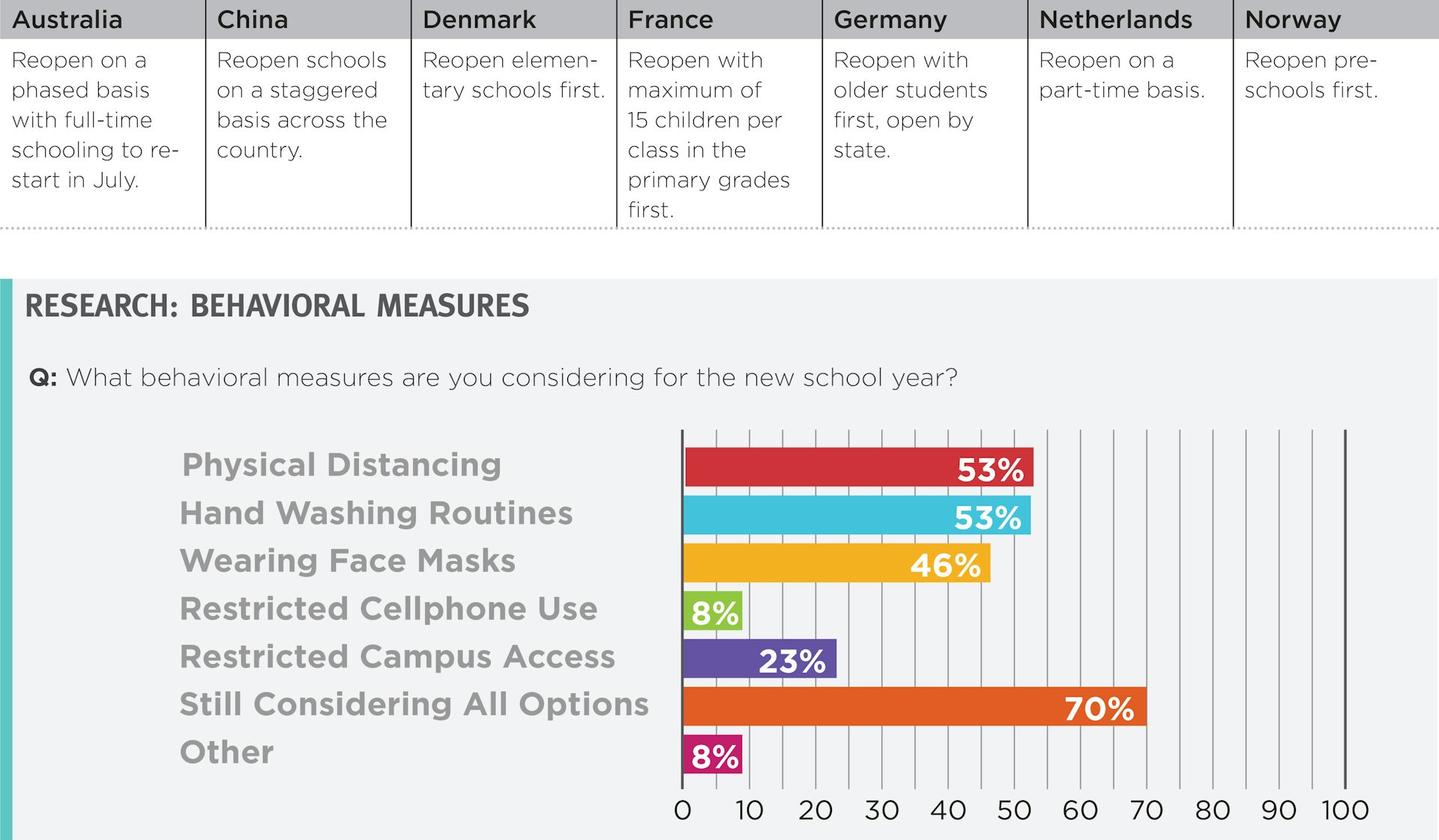Educational organizations are now weighing options as to how to physically reopen schools while maintaining the safety of students and staff and further discourage the spread of the disease. Research articles, policy papers, and practitioner guidelines begin to outline a continuum of strategies for reopening schools that represent minimal, moderate, to substantial changes in structures and behaviors for educational stakeholders.
For this brief, three research articles were reviewed on school management and controlling the spread of disease in schools2 3 4 as well as a policy paper outlining containment and mitigation measures for COVID-19.5 In addition, three practitioner guidelines—two at a country level and one at a county level—were included in the review: 1) Australia Department of Health’s Australia Health Protection Principal Committee released advice on reducing the potential risk of COVID-19 transmission in schools;6 2) United States Department of Health and Human Services’ Centers for Disease Control issued an interim guidance document based on the level of community transmission of COVID-19;7 and, as a county-wide response, the San Diego County Office of Education released its COVID-19 planning assumptions for consideration.8
An Initial Review of School Management Strategies and Controlling the Spread of Disease in Schools
The COVID-19 pandemic has prompted temporary school closures worldwide to control the spread of the disease. According to UNESCO, the closures have affected more than 90% of learners. Overtime, country-wide closures implemented in 191 countries have impacted over 1.5 billion students. Several other countries have used localized closures affecting additional millions of learners.1

A brief web-based news search was also conducted to find initial examples of schools reopening across the world and the range of management strategies being put in place to reduce the risk of contracting COVID-19. Examples from Australia, China, Denmark, France, Germany, Netherlands, and Norway were noted.9 10 11 12 13 14 Finally, the news on possible timeline for schools reopening in the United States is presented. News reports indicate possible initial reopening of schools in seven countries as outlined in the table below.
Strategies abroad for reopening schools reveal some commonalities. The use of physical distancing is a hallmark practice.

Strategies abroad for reopening schools reveal some commonalities. The use of physical distancing is a hallmark practice. In Denmark, students no longer enter through one entrance, but through several side doors depending on the location of their classroom and floor markings show how far apart students must stand. In China, students at some schools use designated lanes to their classroom with separate entrances for different grade levels and classes are dismissed at different times. Germany is also instituting strict physical distancing measures.
Classroom reorganization is a common strategy. In Denmark, classroom desks are spaced further apart, and classes are divided into two or three subgroups. Each new grouping is given its own room and designated teacher. Teachers work with only one small group throughout the day. If a teacher needs a break, a three-person team minds the classroom. Fewer students per group is also planned in Norway where pre-school students are supervised in groups of three. In China, schools aim for fewer students per classroom. Where 50 students in a class might have been the previous norm, there is movement towards classes of 30.
The use of non-classroom areas is also changing to minimize gathering in large groups. In Denmark, school libraries are closed and gatherings outside the classroom require physical distancing. In the Netherlands, only students up through 12-years-old will play sports together. China has modified the use of the cafeteria through assigned tables, partitions, or eating in the classroom and has staggered the use of restrooms.
However, the strategies and dates to physically reopen schools become something of a moving target, as policymakers, practitioners, and community members weigh in on the decision-making.
Health protocols are being instituted. In Denmark, protocols are in place to wash hands at the beginning of the day and then at least once per hour; each door handle is cleaned at least twice during school hours. In China, strategies include the use of body temperature checks, facemasks for students and teachers, and shelves outside each classroom provide disinfection sprayers, thermos bottles, cleaning clothes and other daily necessities.
However, the strategies and dates to physically reopen schools become something of a moving target, as policymakers, practitioners, and community members weigh in on the decision-making. For example, In the United States, 42 states and Washington D.C. indicated they will wait until at least August or September 2020 as the earliest possible return date. Nebraska may reopen in June and North Dakota has an indefinite return date. Six states, Wyoming, Montana, Maryland, New Jersey, New York and Connecticut are considering opening in May. This information, however, changes daily. Just recently, news reports indicate Wyoming is reconsidering the May 1 reopening, the governor of California mentioned a possible phased reopening in July, and the mayor of the city of New York currently disagrees with state leaders regarding reopening schools in May.
For more information on when U.S. schools might physically reopen state-by-state see:
https://www.educationnext.org/... plans shift as new information comes to light regarding the spread of COVID-19, a consensus is emerging about the range of strategies available to best implement the physical reopening of schools. Based on this review of selected research articles and guidelines, examples of strategies designed to mitigate the impact of COVID-19 in schools fell within twelve broad categories:
1. Campus-based learning / Off-campus learning
2. Physical distancing / Community use
3. Classroom organization
4. Hallway / Restroom
5. Staff interaction
6. Common areas / Libraries
7. School yard use / Outdoors
8. Lunch / Dining
9. Physical education
10. Non-classroom activity
11.Transportation
12. Wellness / Environmental cleaning
The following table lists specific strategies mentioned in the reviewed documents from the Australia Department of Health’s Australia Health Protection Principal Committee (Australia AHPCC), the United States Department of Health and Human Services’ Centers for Disease Control (United States CDC), and the San Diego County Office of Education (San Diego COE).
It should be noted, these strategies were presented as guidelines for consideration, rather than requirements for implementation. Moreover, there was an acknowledgement that the application of different strategies is dependent upon the local context, grade level, and/or the level of community transmission in the surrounding area.
---
As an education research consultant, Dr. Cramer is dedicated to the development of deeper learning environments to help all students find their place of impact in the world. As LPA’s exclusive Learning Experience Strategist, Julie works to align learning and teaching goals with physical learning spaces. Julie is a passionate advocate for using dynamic research to support better learning experiences and environments for students. In addition to her work alongside the LPA team and LPAred, Julie is the founder of Wayfind Education, an education research consulting firm.
References + Additional Information
1 United Nations Educational, Scientific, and Cultural Organization (2020). COVID-19 educational disruption and response.
2 Ridenhour, B. J., Braun, A., Teyrasse, T., & Goldsman, D. (2011). Controlling the spread of disease in schools. PloS one, 6(12).
3 Uscher-Pines, L., Schwartz, H. L., Ahmed, F., Zheteyeva, Y., Meza, E., Baker, G., & Uzicanin, A. (2018). School practices to promote social distancing in K-12 schools: review of influenza pandemic policies and practices. BMC public health, 18(1), 406.
4 Viner, R. M., Russell, S. J., Croker, H., Packer, J., Ward, J., Stansfield, C., ... & Booy, R. (2020). School closure and management practices during coronavirus outbreaks including COVID-19: a rapid systematic review. The Lancet Child & Adolescent Health.
5 Organization for Economic Co-operation and Development (2020). Flattening the COVID-19 peak: Containment and mitigation policies
6 Australia Department of Health (2020). Advice on reducing the potential risk of COVID-19 transmission in schools.
7 Centers for Disease Control (2020). Interim guidance for administrators of US K-12 schools and childcare programs to plan, prepare, and respond to corona virus disease (COVID-19).
8 San Diego County Office of Education (2020). COVID-19 planning assumptions.
9 Denmark: https://www.nytimes.com/2020/0... France and Netherlands https://www.dailymail.co.uk/ne... Germany: https://www.reuters.com/articl... Norway: https://www.thehindu.com/news/... China: https://www.chinadaily.com.cn/... Australia: https://www.reuters.com/articl... AHPPC-idUSKBN222364
© Copyright 2020














